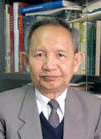

Wang Yuan (1930- ) is a native of Zhenjiang, Jiangsu province. He is a renowned Chinese mathematician, educator and popular science writer. He graduated from the Department of Mathematics, Zhejiang University in 1952. He then earned a position in the Institute of Mathematics, Chinese Academy of Sciences. He is an academician of Chinese Academy of Science, a former president of the Chinese Mathematical Society, and head of the Institute of Mathematics, Chinese Academy of Sciences. Hua Loo Keng (or Hua luogeng) is considered as his main academic advisor and one of his closest collaborators. In 1946-1949, he was the Acting Director of the institute. In 1978, Wang was back to his professorship, in the Institute of Mathematics, Chinese Academy of Science. In 1980, he was elected to be an academician of Chinese Academy of Science. In 1988-1992, he was the president of the Chinese Mathematical Society.
Most of Wang Yuan's research has been in the area of number theory. He looked at sieve methods and applied them to the Goldbach Conjecture. He also applied circle methods to the Goldbach Conjecture. His research towards Goldbach Conjecture together with Chen Jingrun and Pan Chengdong won State Natural Sciences Award, First Class in 1981. He put forward the representation of large even integer as a sum of a prime and a product of at most 4 primes in which he assumed the truth of the Riemann hypothesis and with that assumption proved that every large even integer is the sum of a prime and of a product of at most 4 primes. He obtained a series of important results in the field of number theory.
He was also honored with many prizes for his books promoting mathematical learning. He wrote a number of books such as: (with Hua Loo Keng) Applications of number theory to numerical analysis (1978); Goldbach Conjecture (1984); (with Hua Loo Keng) Popularising mathematical methods in the People's Republic of China (1989); Diophantine equations and inequalities in algebraic number fields (1991); (with Fang Kai-Tai) Number theoretic methods in statistics (1994); Hua Loo Keng (1995); and (with Fong Yuen) Calculus (1997).
APPLICATION OF NUMBER THEORY TO APPROXIMATION ANALYSIS
Hua Loo Keng and Wang Yuan
(Institute of Mathematics, Chinese Academy of Sciences)
Abstract
The basic idea of Monte Carlo method is to replace an analytic problem by a probabilistic problem with the same solution and then investigate the later problem by statistical simulation. Hence we need a set of so called random numbers in Monte Carlo method. The basic idea of number -theoretic method is to construct by number theory a set of points which is uniformly scattered in a given domain such as rectangle, ball, sphere or simplex. This set of points is called quasi-random numbers which may be used instead of random numbers in statistical simulation, and it often leads to more precise results than Monte Carlo method in many known cases such as multiple quadratures. The authors proposed a method in 1959-1964 to construct quasi-random numbers by the use of algebraic number theory and Diophantine approximations. This method has advantages compared with the known number-theoretic method, in particular, when the dimension of domain for simulation is high or the number of points is large. This method is usually called the Hua-Wang method.